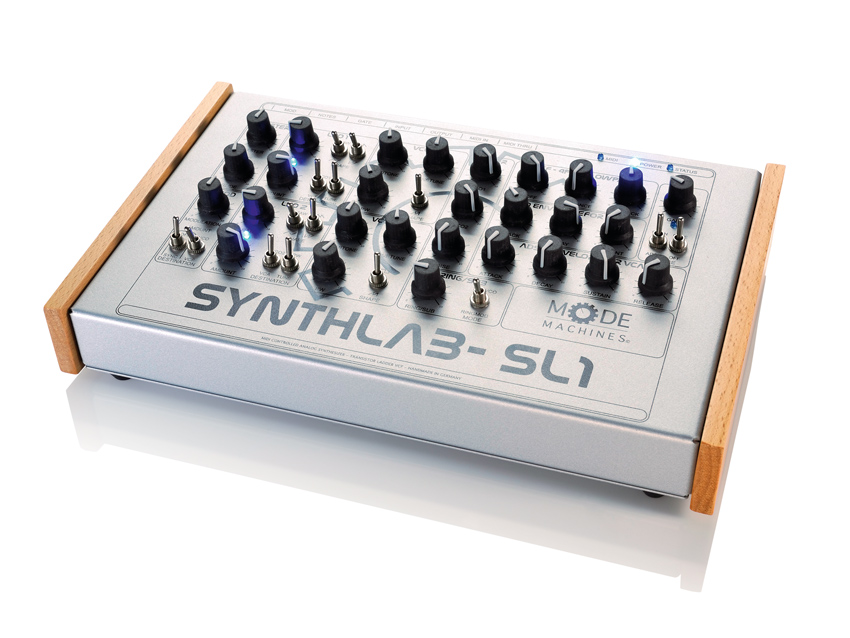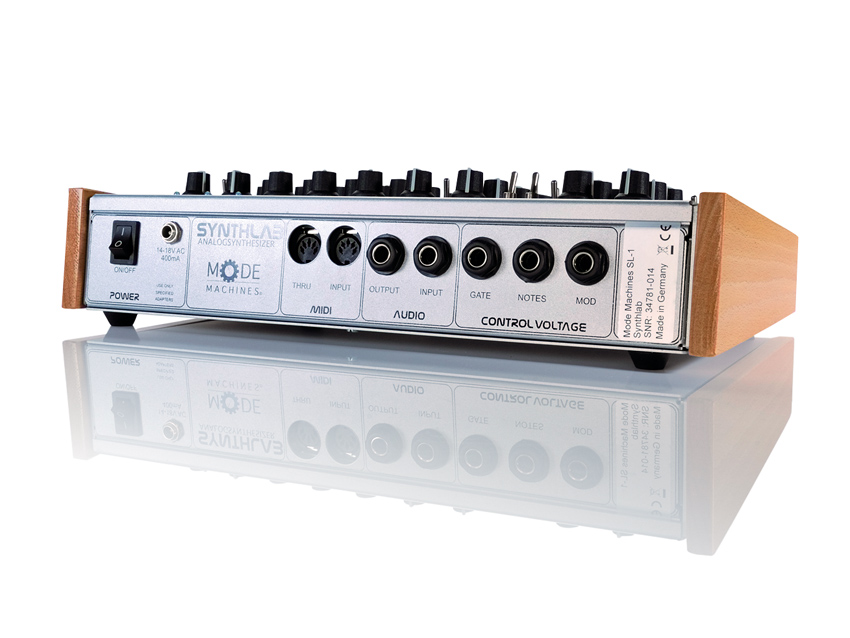MusicRadar Verdict
A versatile mono synth, but unlikely to tempt buyers from the Slim Phatty or cheaper alternatives.
Pros
- +
Great hands-on appeal. Nice phat sound.
Cons
- -
Not as easy to use as modern synths.
MusicRadar's got your back

Mode Machines Synthlab SL1

Mode Machines Synthlab SL1
Fresh off the production line from German analogue fiends Mode Machines, the SL1 is an all-new mono synth with an approach unashamedly inspired by the classics.
The synth's only concession to modern ease of use is built-in MIDI to CV conversion. Otherwise, it's old-school all the way, with classic one-function-per-knob programming at its best.
"The SL1 delivers analogue phatness by the bucketload and the options provide plenty of versatility."
Based around a two-oscillator subtractive synthesis architecture and a Minimoog-derived low-pass fi lter, the SL1 certainly promises analogue fatness by the bucketload.
All-analogue
On paper, the Synthlab ticks all the right boxes. The sturdy steel enclosure houses two oscillators, two LFOs, a low-pass filter, separate amplitude and filter envelopes, plus ring mod, sub-oscillator and a noise source.
The VCOs each offer pulse or sawtooth waves (not available simultaneously), while the two identical LFO sections offer triangle, sawtooth or reverse saw waves, with the rate indicated by ultra-bright blue LEDs.
LFO1's output can be routed to VCF cutoff or VCO1 (pitch or pulse width), while LFO2 can be routed to the VCA or VCO2. The VCA envelope is the standard ADSR variety but the filter envelope is a more basic AD affair with an adjustable amount control. Finally, the ring/sub section controls the level of either sub-oscillator or ring modulation.
Infuriatingly, the sub-oscillator frequency is one of a handful of settings accessible only via jumpers and trimmers on the SL1's PCB. Some, such as CV tracking rates, should really only be adjusted by a knowledgeable tech, but wouldn't it make sense for the sub-oscillator frequency or LFO range to be adjustable via front panel controls?
Other than that strange decision, the SL1 compares well to the competition in terms of specification. But the spec counts for nothing unless the sound can back it up…
Phat and phun
Plugging in the external power supply and flicking the power switch round the back of the unit, it's interesting to note that MIDI In and Thru are via five-pin DIN only, with no USB option.
In keeping with the old-school approach the Synthlab offers no patch memories, no software editing, and no MIDI CC control of parameters.
Don't expect all the convenience of most modern synths, but the SL1 easily holds its own in terms of hands-on appeal. Hook a keyboard up to the MIDI input and the simplicity of the one-function-per-knob approach makes it an absolute joy to start programming sounds.
There's something about the tactile vibe of knobby analogue mono synths that makes them incredible addictive and more fun than menu-based editing or software control.
The only major weakness is that the rubberised knobs on the SL1's 28 rotary pots are undeniably wobbly. No worse than most vintage analogue synths, but not really up to modern standards.
The sound of the SL1 delivers analogue phatness by the bucketload and the nice balance of options provides plenty of versatility. The oscillators are stable and easily tuned - although we'd prefer to see octave range switches rather than the more fiddly coarse tuning pots - and the dual LFOs provide useful modulation options.
Dial in some subtle PWM from the LFOs, crank up the sub-oscillator and you'll be blowing subwoofers and causing structural damage to your walls in no time.
The VCF employs the same transistor ladder design found in the Minimoog, and in terms of sonic character it's remarkably similar.
For more advanced tweaking it would be nice to see a VCO cross-modulation option but the ring modulator and dedicated filter envelope offer nice flexible additions to the basic sonic range.
The elephant in the room
If you're in the market for a synth inspired by the classic Minimoog sound, the SL1 fits the bill perfectly. Unfortunately, there's one crucial factor which can't be ignored: at an RRP of £799 but a street price around £600, the SL1 is priced perilously close to Moog's own Slim Phatty (officially priced at £699 but widely available for less), a similarly Minimoog-inspired synth with four decades of American synth heritage behind it.
For the small amount of extra cash, the Moog offers a number of advantages over the SL1, including USB MIDI, more versatile oscillators and a built-in arpeggiator.
It's not that the Synthlab is unfairly priced - you'd expect to pay a small premium for a hand-built synth from a boutique manufacturer - but the Moog is going to be a seriously attractive prospect for potential SL1 buyers.
The Synthlab has the clear advantage of one-function-per-knob operation, but otherwise it's hard to see why you'd choose it over the Moog. The SL1 is a very good synth, but it doesn't quite have the X-factor required to make it stand out from the competition.
If it were slightly cheaper we'd have absolutely no hesitation in recommending it, but this is now a seriously competitive market. Ignore the price and competition and there's no doubt the Synthlab offers a great package.
The sound is Minimoog-inspired thanks to the transistor ladder filter, but the inclusion of ring modulation and dual LFOs offers plenty of useful synthesis options.
Likewise, the one function per knob approach is a refreshing antidote to menu-based editing and multi-function controls.
However, it's impossible to ignore the competition. Judged against the likes of the Slim Phatty, Mopho and Dark Energy, the Synthlab comes up short in a number of areas.
If you're in the market for a desktop analogue module the SL1 deserves to be on your shortlist, but it's got its work cut out against some great rivals.
Future Music is the number one magazine for today's producers. Packed with technique and technology we'll help you make great new music. All-access artist interviews, in-depth gear reviews, essential production tutorials and much more. Every marvellous monthly edition features reliable reviews of the latest and greatest hardware and software technology and techniques, unparalleled advice, in-depth interviews, sensational free samples and so much more to improve the experience and outcome of your music-making.
"The Rehearsal is compact, does its one job well, and is easy to navigate without needing instructions": Walrus Audio Canvas Rehearsal review
“The EP635 delivers the unmistakable high-gain aggression and clarity that Engl fans love”: Engl packs its iconic Fireball head into a compact dual-channel stompbox with onboard noise gate and IR support
"There had to be some sort of telepathy going on because I've never seen spontaneous inspiration happen at that level”: The genius of Eric Clapton's controversial masterpiece, Layla










